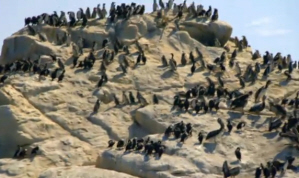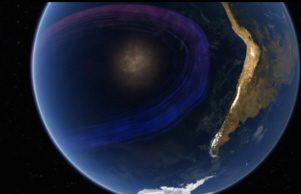Ocean Gyres
The Humboldt Current

Humboldt Penguins
That's not the end of the way the Coriolis effect influences our planet. It also affects the oceans. I've come to Chile, to the world's biggest ocean, the Pacific, to see a dramatic example of how the Coriolis effect has transformed the ocean and the life that depends on it.
Humboldt penguins are an endangered species of penguin that live in temperate climates. They and all the other birds are here for just one thing - fish. This is one of the richest fishing grounds in the world. Less than 1% of the planet's ocean provides up to 20% of the total fish catch. And they're all here as a direct result of the spin of our planet.
There are plenty of fish here because of a nutrient-rich current of water that flows right along the west coast of South America. It shares it#s name with the penguins. It's called the Humboldt Current. Just as the Coriolis effect deflects the winds, it also deflects surface currents in the ocean. It turns them to the right in the northern hemisphere, creating a clockwise spiral, and here, in the southern hemisphere, it turns the currents to the left, forming a counter-clockwise spiral. These spirals are called gyres.
Despite the fact that we're so close to the tropics, the water is freezing, because the current originates in Antarctica and travels all the way up here . That cold Antarctic water is driven up along the coast by the South Pacific Gyre. Yhe current pulls nutrients up from the depths, and these sustain the largest fishery on Earth. And, in turn, quite a lot of sea birds.

The Southern Gyre
This circular flow of water is a phenomenon repeated around the world. There are similar ocean currents in the North and South Atlantic, and in the Indian Ocean. The Earth's spin creates large-scale circulation patterns in both the oceans and atmosphere. These patterns define the weather and control the ocean circulation across the planet.
But, the Earth's spin has another influence on the oceans. And it reaches a peak at this time of year, in early autumn. The tides.
